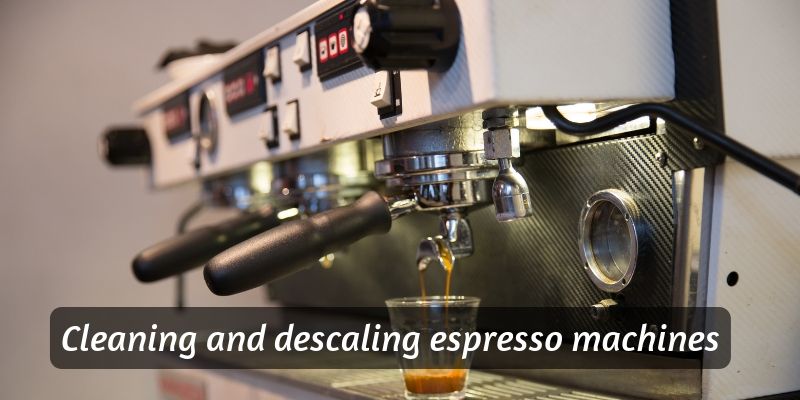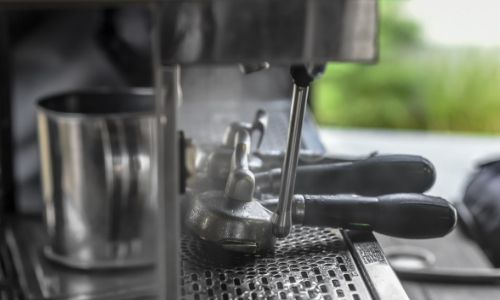Cleaning and descaling your espresso machine is actually the first step towards getting the best cup of espresso possible.
A machine with built up coffee oils and grit will muck up even the best coffee bean you can purchase. Besides, keeping the machine clean is going to save you money in the long run, and cushion the investment you made in the machine to begin with.
So, this guide is going to walk you through cleaning and descaling your espresso machine, with a daily, weekly and monthly cleaning routine.

Table of Contents
How to clean an espresso machine
This guide is going to walk you through cleaning your espresso machine. This first part does not include actively descaling the machine, but the steps taken here will ensure you have less of a problem when descaling the machine, and prevent too much buildup.
Of course, if you live in a hard water area, limescale will build up much faster, so you might want to consider using filtered water.
Daily clean (for light home use)
This daily cleaning routine is means to help you care for your espresso, if you're a home barista and your espresso machine gets light use.
By light use I mean less than 5 espresso shots per day, except when guests are over.
If you're a professional barista and your espresso gets a whole lot of traffic, skip to the weekly routine and apply that daily.
1. Run hot water through the machine (rinse)
With just a few shots of espresso each day, your espresso machine will be alright if you only rinse it with its own hot water after you're done brewing.
Most folks have an informal cutoff time when they stop making coffee - for example my last coffee is somewhere around 5 PM - meaning you can clean the machine then, and no one will use it until morning.
To simply rise the espresso machine, first take out the portafilter. Make sure it has no coffee leftover inside, and is at least rinsed in the sink.
Lock the portafilter back in, and place a large empty cup under it to catch the water.
Let the machine run until the cup is full (a few minutes). Once it's done, remove the portafilter and rinse it again in the sink.
If your espresso machine has a built-in coffee grinder, remove the use ground coffee and very thoroughly rise the tray in hot, soapy water.
Recommended post: Espresso Extraction
2. Wipe and purge steam wand
The steam wand can collect milk in time and needs regular purging. Turn on the steam wand and let it purge for a full minute, to make sure you've gotten everything out.
Wipe the outer side of the steam wand with a damp, wet cloth and then a dry one.
If you do this daily, it should be enough to keep the mess and grime manageable until the week is over, and you can clean the machine a little more thoroughly.
Weekly cleaning routine
If you keep the daily cleaning routine and never miss a day, your machine should be mostly clean by the end of the week. However coffee oils can and do built up in nooks and crannies, and simply rinsing the machine won't be enough.
Which is why we're also going to clean the inside of the espresso machine with a light solution, just to make sure we've got everything clean.
1. Backwash the espresso machine with baking soda
The first thing to do is to make the espresso machine clean itself on the inside. Now, what this means is that we're going to force the machine to backwash, unless your machine has a specific setting for inner cleaning.
What you need to do is swap the portafilter's filter with a blind filter. A blind filter is a disk with absolutely no holes in it, which means you're going to effectively block the espresso machine from running the water completely.
You're going to need to empty the water tank before we begin, and instead use warm purifier water, with a tablespoon of baking soda.
This will change the water's pH, meaning it will also remove odors and grime hidden inside the machine, wherever the water will pass.
Make sure you sue warm water, so the baking soda completely dissolves into the water.
Pour all the water into the water tank, and make sure you've got it full and the blind filter inserted into the portafilter.
Lock the portafilter into place, and run a shot of espresso for about 5 seconds to fill the portafilter. Stop it, and let it sit for about 10-15 seconds, so the water will eventually dislodge any grime, grit, or coffee oils that built up since last week.
When you remove the portafilter be careful not to burn yourself with the hot water. Throw the water into the sink, and remove the blind filter.
We've done this so the group head will be soaked in the baking soda water and now it's time to rinse the portafilter as well.
Lock it back into place, without the blind filter, and let the machine run until it runs out of water.
Refill the tank with clean, fresh water, then run the water for at least half a tank, if not all of it to completely remove any residue from the baking soda water.
If baking soda isn't your thing, then you can swap it for any commercial cleaning agent meant for espresso machines.
2. Wipe and purge steam wand
Again, you will need to purge and wipe the steam wand. That's going to be done pretty much every day, just to make sure there is no buildup.
A note for those who take their coffee black, and never or rarely use the steam wand: you can do this only once every couple of weeks, since there is nothing that's going to built up on the wand except dust.
Also remember to remove the used ground coffee and clean the tray.
Monthly cleaning routine
If you've kept up with the weekly cleaning routine then by the end of the month you should have a mostly clean espresso machine.
However, limescale might built up and you're always going to need to completely scrub down the machine, to make sure no coffee oils or grit has built up over time.
1. Hot rise the espresso machine
You'll start with a hot rinse, since that's going to heat up the machine and also make things much easier to scrub off (heat tends to do that, like for a grill).
Make sure your collecting tray is empty, since you're going to let the hot water run through the grouphead and portafilter and empty into the tray, meaning you'll also give that a hot rinse.
Once about half the water in the tank has gone, stop the machine.
Make sure you wear heat protective gloves, or at least some sort of gloves since this whole operation might get very, very hot.
2. Disassemble every item, give it a good wipe down and scrub
Lay out several clean towels, and begin disassembling as much of the espresso machine as you can. You don't need all of it, but you're going to need to reach the portafilter, the grouphead and its gasket, the catch tray, steam wand and anything that's meant to me moved around.
As you remove them, remember how they were each put together. You can take some photos for reference.
Get yourself a grouphead brush that's going to help you scrub the inside much better, and even reach into places a dish sponge won't.
This one by Number-One is actually a set of two brushes with a scoop at the end, so help you measure out the cleaning powders better.
It's sturdy, and the brush itself is stiff enough which is very important, since you're going to be brushing a bit hard at the valves and so on.
Another important point is the fact that it's got a nice raised ridge close to the brush head, which is going to prevent water from running down the entire shaft and onto your hands when you clean the machine.
You can find the listing on Amazon here, and read the reviews as well.
With your brush wash the gasket with soapy water, and the portafilter as much as you can, and again purge the steam wand.
This is possibly the most time consuming operation you'll have to do, but it's a small price to pa for the perfect espresso cup.
Clean the catch tray, and wipe down the entire outside of the espresso machine.
Once every part of the espresso machine has been cleaned, at least to best of your abilities, put everything back together. We're going to run a final cleanse and be done with everything,
3. Add commercial cleaning agent to your espresso machine's water
Most espresso machines come with a couple of suggestions of what kind of cleaning agent is safe to use, going as far as naming brands and suppliers you can choose from.
Consult the user's manual to see if your machine comes with such a suggestion. If it does, follow it and follow the instructions in the manual.
If the machine does not come with a specific cleaning agent meant for it, then you can try this one from Cofiza. Not too hard on the machine, since it's also recommended for a daily backwash regimen.
Since it's powder form it's going to be easier to control how much of it you add to the water. It's a 20 oz bottle, so it's going to last you a few months.
It's meant to flush out any residue, coffee oils and grip that may have built up in the grouphead, filter and valves so it's going to o its job just right.
You can check the listing on Amazon here, and read the reviews as well.
Finally, run an entire tank of hot water through the machine. This will ensure you've gotten all the detergent out of your machine, and it's also going to provide a final hot rise.
This is a lot of water, I know, but espresso is espresso and having your machine completely clean is key here.
How to descale an espresso machine
Descaling your espresso machine is a little different than simply cleaning the machine.
Luckily it's not as complex a process, since you're only going to need to rinse the machine with a solution.
As for how often, more than once every 4-6 months won't be necessary. This is because in ares with regular water the buildup requires several months, even years.
If you live in a hardwater area, you'll have to do this more often, possibly every 3 months. This strip test fro Amazon can tell you the quality of your drinking water.
This way you'll know how hard or soft your water is, which can influence everything, including washing machine, dishwasher, toilets, and so on.
Use vinegar, citric acid, or commercial descaler
There's several ways you can do this. You can use vinegar or citric acid, or a commercial descaler. Funny enough, most commercial descalers are simply citric acid that's already blended with water.
If you decide to use vinegar then know that you're going to need to do some very thorough rinsing after you're done. The small can stay there for a long time, and no one wants to smell hot vinegar.
1. Run the solution through the machine once
If using vinegar make a solution of 1:2 vinegar and water, and fill the tank. Let it run completely, then run an entire tank of clean water to rinse the machine.
If you still smell vinegar, run another full tank.
Vinegar should not be balsamic vinegar ! Use only white or distilled vinegar.
If it has the floaty bits at the bottom of the bottle, it's still safe to use, just make sure those bits don't get into the espresso machine.
If using citric acid, you can dissolve about 3 tablespoons of citric acid to a full tank of water, and make sure the water is warm to completely dissolve it.
Run the full tank of water to descale the machine, and then run another full tank of clean water to rinse.
If using a commercial descaling agent, make sure you follow the instructions printed on the package. And then run an entire tank of clean water to rinse.
You can find a good descaling agent on Amazon, and it comes as a 2-pack.
Conclusion
Cleaning and descaling your espresso machine is what's going to keep it alive and kicking for years to come. When you buckle up and decide to get yourself one of these bad boys, it's a bit of an investment.
Taking very good care of it will spare you money down the line, and it's also going to make sure you get a good cup of espresso every time your brew.
A good espresso is a clean espresso. If your espresso has become especially bitter or sour, a good, deep cleaning might just do the trick.









